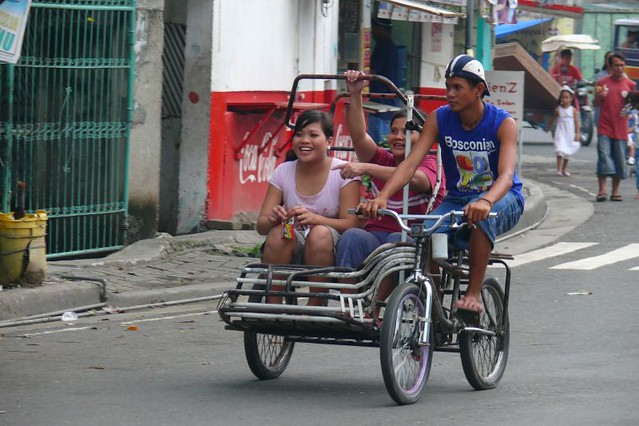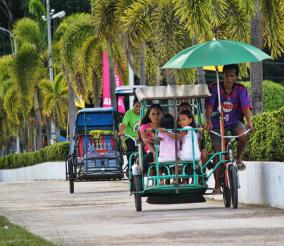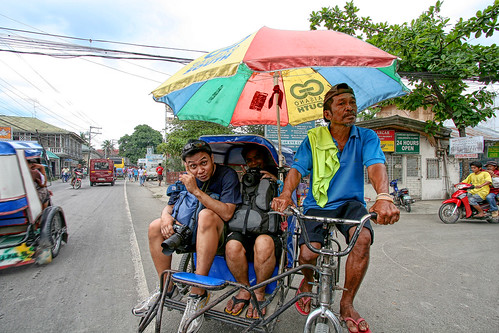
-
МјРЇСІИёСЖШИМі
-
 Malacañang Palace-Official Residence of the Pres
Malacañang Palace-Official Residence of the Pres 138,879
138,879 -
 Amana Water Park
Amana Water Park 115,400
115,400 -
 IFUGAO TRIBE
IFUGAO TRIBE 109,383
109,383 -
 Santacruzan-The Queen of all Filipino Festivals109,269
Santacruzan-The Queen of all Filipino Festivals109,269 -
 Water Refilling Station: an alternative source of drink107,158
Water Refilling Station: an alternative source of drink107,158 -
 LAMBANOG-THE POOR MAN\'S DRINK104,512
LAMBANOG-THE POOR MAN\'S DRINK104,512 -
 Christmas Parol [lantern in English]104,359
Christmas Parol [lantern in English]104,359 -
 HANGING RICE97,032
HANGING RICE97,032 -
 Taoist Temple93,994
Taoist Temple93,994 -
 Corn Fields in the Philippines90,466
Corn Fields in the Philippines90,466

The cycle rickshaw is a small-scale local means of transport; it is also known by a variety of other names such as bike taxi, velotaxi, pedicab, bikecab,
cyclo, beca, becak, trisikad, or trishaw.
As opposed to rickshaws pulled by a person on foot, cycle rickshaws are human-powered by pedaling. Another type of rickshaw is the auto rickshaw.
They are a type of tricycle designed to carry passengers on a for hire basis. Cycle rickshaws are widely used in major cities around the world,
but most commonly in cities of South, Southeast and East Asia.
The cycle rickshaw was built in the 1880s and was first used with regularity starting in 1929 in Singapore. Six years later they outnumbered pulled rickshaws.
Cycle rickshaws were found in every south and east Asian country by 1950. By the late 1980s there were estimated 4 million cycle rickshaws in the world.[1]
The vehicle is generally pedal-driven by a driver, though some are equipped with an electric motor to assist the driver.[
Trisikad is a Cebuano term for a cycle rickshaw. It is a known mode of transportation in the Philippines. It comes in many names in different parts of the countries.
Some call them tadyak, pedicab, and potpot, among others. There isnЁЏt really a clear history on how this mode of transportation began.
However, it is said that the first one was built in Tondo, Metro Manila -- somewhere in the northern part of the Philippines.
This came out because of the poverty that was prevalent in the National Capital Region then which did the maintenance of motorized tricycles.
The trisikad is a modification of the common bicycle. This is a proof of the ingenuity of the Filipinos by making something better out of an ordinary bike.
By adding another wheel, a bench for two or three persons and a little roof just over the heads of the passengers, the bicycle can already
be used as a means for earning money. Instead of only carrying one person, the trisikad can carry three passengers.
You can find trisikads almost everywhere in Cebu, be it in the busy city or in the far provinces. In Metro Cebu, however, trisikads are kept in the small
streets and residential areas that donЁЏt cause too much traffic or motorists. This is to ensure the safety of the drivers and of the passengers.
They are also used to ferry passengers with cargoes that are too heavy to hand carry.
- ЁЄfYGbJbhcBF

- ЁЄfYGbJbhcBF

- ЁЄfYGbJbhcBF

- ЁЄfYGbJbhcBF

- ЁЄfYGbJbhcBF

- ЁЄfYGbJbhcBF

- ЁЄfYGbJbhcBF

- ЁЄfYGbJbhcBF

- ЁЄfYGbJbhcBF

- ЁЄfYGbJbhcBF

- ЁЄfYGbJbhcBF

- ЁЄfYGbJbhcBF

- ЁЄfYGbJbhcBF

- ЁЄfYGbJbhcBF

- ЁЄfYGbJbhcBF




- ЁЄSaDEVEqmgq

- ЁЄSaDEVEqmgq

- ЁЄSaDEVEqmgq\'\"\\(

- ЁЄSaDEVEqmgqщ\'\"\\(

- ЁЄSaDEVEqmgq

- ЁЄSaDEVEqmgq

- ЁЄSaDEVEqmgq

- ЁЄSaDEVEqmgq

- ЁЄSaDEVEqmgq

- ЁЄSaDEVEqmgq

- ЁЄSaDEVEqmgq

- ЁЄSaDEVEqmgq

- ЁЄSaDEVEqmgq

- ЁЄSaDEVEqmgq

- ЁЄSaDEVEqmgq




- ЁЄqpvwYmzPrC

- ЁЄqpvwYmzPrC

- ЁЄqpvwYmzPrC

- ЁЄqpvwYmzPrC

- ЁЄqpvwYmzPrC

- ЁЄqpvwYmzPrC

- ЁЄqpvwYmzPrC

- ЁЄqpvwYmzPrC

- ЁЄqpvwYmzPrC\'\"\\(

- ЁЄqpvwYmzPrCщ\'\"\\(

- ЁЄqpvwYmzPrC

- ЁЄqpvwYmzPrC

- ЁЄqpvwYmzPrC

- ЁЄqpvwYmzPrC

- ЁЄqpvwYmzPrC














 ЧЪРкДхФФ ОпАЃЛѓДу ПРЧТ
ЧЪРкДхФФ ОпАЃЛѓДу ПРЧТ 11ГтПЌМг МвКёРкИИСЗ 1РЇ
11ГтПЌМг МвКёРкИИСЗ 1РЇ
 ГЛАд ИТДТ ОюЧаПј УЃБт
ГЛАд ИТДТ ОюЧаПј УЃБт
 ИЎОѓ ЧаБГ ЙцЙЎБт
ИЎОѓ ЧаБГ ЙцЙЎБт
 СжИЛПЁ ГЛАЁ ОЕ КёПыРК?
СжИЛПЁ ГЛАЁ ОЕ КёПыРК? УжАэАЁМККё РЬКЅЦЎ СёБтБт
УжАэАЁМККё РЬКЅЦЎ СёБтБт
 ЧіСіПЁМЕЕ ЧЪРкДхФФ!
ЧіСіПЁМЕЕ ЧЪРкДхФФ! ЧіСіПЁМ АЁДЩЧб
ЧіСіПЁМ АЁДЩЧб









 ЧЪРк ЦЏБо Ч§ХУ! ФСНУОюСі МКёНК
ЧЪРк ЦЏБо Ч§ХУ! ФСНУОюСі МКёНК



 АЁСЗПЌМіЗЮ ДйЧдАд ОзЦМКёЦМ
АЁСЗПЌМіЗЮ ДйЧдАд ОзЦМКёЦМ


































